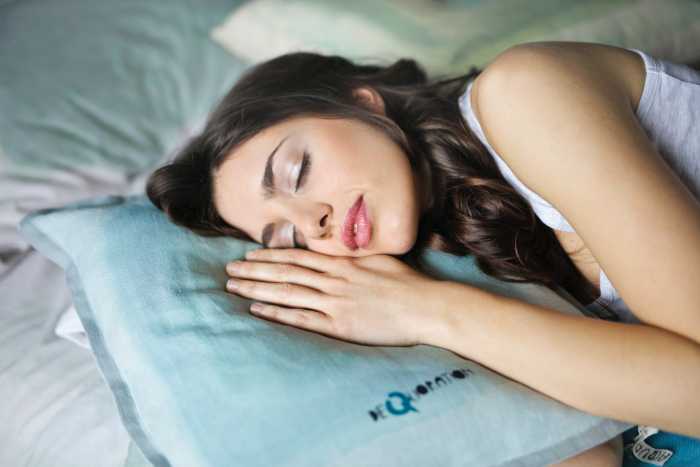In winter it seems like you never get enough sleep. Waking up in the morning gets harder and harder and you feel that night sleep doesn’t give you sufficient rest. How to make your sleep more productive and waking up less painful?

Temperature and air humidity in the bedroom
When it’s cold outside, the best temperature in your bedroom would be 17-18°C (62-64°F). 19-22°C (65-69°F) would still also be acceptable. Keeping this temperature prevents headaches and insomnia.
As for the humidity in your bedroom, it should ideally be 30-45% in winter. 60% would be the acceptable maximum. Make sure you ventilate the room before going to sleep and in the morning.
It’s a great idea to sleep with an open window because it provides the necessary oxygen supply. But you shouldn’t freeze. So don’t open the window widely for the whole night. Keeping a small window open in the neighboring room or the next bathroom while having the doors open would also provide fresh air and contribute to healthy sleep.
Recommended sleep length in winter

As for the sleep length, it depends on the person. Some feel pretty good after just 5-6 hours of sleep while others still feel tired after 10 hours. Keep in mind that feeling bad after a long sleep could also be a sign of health issues.
Scientists claim, the perfect sleep length is 7,5 to 9 hours of sleep daily both in winter and summer.
Waking up early in winter: how to survive?
Waking up early in the morning is not pleasant per se, but in winter it causes even more discomfort. Your body just refuses to while it’s still dark outside. The reason is, your eyes react to the lack of light and send a corresponding signal to your brain.
In the end, the sleep hormone melatonin is still working, while the production of cortisol is inhibited. Only by having enough sunlight we finally receive the cortisol and wake up easily.
However, it’s still possible to make an early rise comfortable and easy. Try to use one of the following methods.
An instant rise
Stand up as soon as your alarm starts to ring. No snooze. No more “just 5 minutes more”. The thing is, an extended rise will make it hard for your brain to quickly get into a working rhythm, and as a result, you feel lethargic almost all day.
Morning exercise
5 to 10 minutes of exercise in the morning promotes cortisol production and helps to wake up quickly. You can even do exercises while still in bed.
Cold and hot shower
For those who are not that fond of exercising, take a cold and hot shower. At first, it will be light stress for your body, but cortisol production will also be triggered.
Drink a cup of coffee
This is probably the easiest and most pleasant way to feel awake in the morning. A cup of coffee and something sweet containing carbs help too. But don’t forget about the healthy breakfast. It shouldn’t be just coffee and cake or a chocolate bar.
Citrus fruits, such as grapefruit or orange, invigorate your mind very well in the morning. But don’t eat them on an empty stomach, otherwise, it could lead to bloating.
Use a smart alarm gadget or app
There are plenty of smart gadgets and apps that help you wake up easily and with minimum stress. Some imitate the dawn and get lighter little by little, so that your bedroom is full of artificial sunlight when it’s time to get up. This makes the process less stressful, especially in winter.
Foods before sleep
According to some researches, eating after 7 pm raises your blood pressure, which stays the same during the whole night and also increases the risk of a heart attack. The best recommendation here is don’t eat too much in the evening, reduce salt intake.
Eating later than two hours before bedtime also causes heaviness in the stomach. You won’t feel rested after it, because your body will be busy digesting. As for the excess weight gain, you already know everything – we’ve written a log about it.
Choosing the right blanket in winter
What is the best blanket for the winter? Choose it according to your own preferences and depending on your health issues (any allergies?) and room temperature.
Down and feather blankets
Down and feather blankets are very popular. But pure down is softer. A pure feather blanket would be too heavy and difficult to clean, also it shouldn’t be used by those suffering from allergies, also because feathers are often bleached.
Woolen blankets
Woolen blankets are acceptable if you’re not allergic. It could be a camel or sheep wool, for example. Such blankets are very warm but absorb moisture well.
Synthetic blankets
Don’t be afraid of synthetic fillers. There are ecological and harmless synthetic materials, such as holofiber. It’s often used for kids’ pillows. A great thing about it is that you can decide how much of it to use and, thus, change the volume of the pillow and the blanket. Depending on how much is put inside, the warmth also varies.
What is also great about synthetic blankets is:
- you can wash it in the washing machine,
- the dust mites don’t enjoy living in synthetic blankets,
- it’s light,
- its shape keeps the same.
Silk blankets
Silk blankets are also lightweight and hypoallergenic. They create a comfortable micro-climate in summer and keeps warm in winter. Silk blankets consist of layers of long-staple silk, such as Mulberry or Tussah silk. These layers are put in a net shape, which lets the air circulate through it. Unfortunately, you can’t wash such blankets.
How to Choose the right pillow?

Choose a pillow depending on your most frequent sleep position.
Pillows for those sleeping on the side
If you sleep on your side, choose two pillows – a soft one and a hard one. The height depends on the width of your shoulders. It’s a good idea for more comfort to put a small pillow between your knees like many pregnant women do.
Sleeping on the belly: what pillow to chose?
If you’re a back or belly sleeper, select a soft one that will support your head during sleep. A holofiber one is probably the best choice, for you can decide on its size and volume and vary it. The more holofiber, the harder the pillow. It’s hypoallergenic and easy to wash in the washing machine.
If you prefer natural fillers, choose feather or down. More feather means a harder pillow, while more or pure down makes a softer pillow. It’s comfortable to sleep on such pillows, but they should be changed more often, can’t be cleaned at home, absorb moisture, and get dirty more often. Besides, it’s a nice place for dust mites to live.
When to change the pillow?
It’s time to throw away a pillow if its color has changed. Every night we lose about 500 milliliters moisture that is absorbed by the pillow.
If your pillow starts smelling, it’s a sign that there are bacteria growing and it’s time to buy a new one.
Another sign is you wake up with headache or neck pains. It means your pillow has probably lost its shape. And when it doesn’t fulfill its main function anymore, that is, supporting your head and neck during sleep, buy a new one.
Another reason to change a pillow is waking up with a stuffy nose. You might be allergic to the pillow filler or dust mites.
The best way to know if you have the right pillow is to try it. If you feel comfortable and nothing is wrong (you don’t feel any pains, it doesn’t seem that the pillow is too low or too high, you can relax lying on it), then buy it and remember the brand for the next time.
Some other tips to get better sleep in winter
- Eating some cheese or drinking milk in the evening helps you sleep better.
- Exercising in the evening treats insomnia and helps fall asleep faster.
- A 20-minute walk in the fresh air is also great for better sleep.
So, these were our tips on getting good and resting sleep in winter. Good night!










